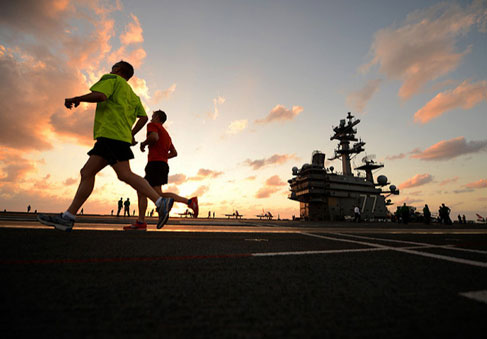Cardiovascular exercise trains your heart and blood vessels, which enhances the movement of blood through your body. With regular training, you’ll see improvements such as lower resting heart rate, increased stroke volume (how much blood your heart moves in a single contraction), lower resting blood pressure, and more capillaries (small blood vessels) in your muscles.
Train your heart
Training to improve cardiorespiratory endurance—also called aerobic training—enhances cardiovascular function. When you start an exercise session, and as you train over time, your heart’s stroke volume increases by two mechanisms. Your “fight-or-flight” system makes your blood vessels contract when you start a cardio session, which slightly increases your blood pressure. This, combined with the blood-pumping action your muscles create when you exercise, sends more blood to your heart than when you’re at rest. More blood to the heart means the heart can move more blood with each contraction, which increases stroke volume. The second mechanism, also caused by your fight-or-flight response, releases epinephrine and norepinephrine into your bloodstream. This causes your heart to contract harder, which pushes more blood out of your heart with each contraction.
Over time, this training will lead to higher stroke volume, even at rest. As your stroke volume goes up, your heart doesn’t need to contract as quickly to move the same amount of blood through your body. This leads to lower resting heart rates for very fit people. It also causes some structural changes to the heart, such as increased left ventricle size and muscle thickness. The left ventricle is the chamber in your heart that pumps the blood out of your heart and into your body. This increased size and muscle thickness is often called athletic heart syndrome, which is a normal and safe response to training, and is often seen as a good thing. (Don’t confuse it with hypertrophic cardiomyopathy, which is a life-threatening enlargement of the heart.)
Heavy resistance training to improve muscular strength and high-volume resistance training with short rest periods for muscle hypertrophy also improve cardiovascular function, but in a different way than aerobic training. When you perform a heavy lift—such as a 1-rep max squat—your blood pressure can go up 2–3 times what it normally is at rest. The pressure created when you lift actually limits blood flow. Your heart works to catch up to deliver blood to your muscles during the rest periods.
With time, resistance training can slightly lower your resting heart rate and resting blood pressure, but not as much as aerobic training does. Resting cardiovascular-function adaptations (for example, stroke volume) are most often caused by high-volume, short-rest training such as hypertrophy or muscular endurance training. The increased pressure caused by resistance training also contributes to greater heart-muscle thickness. This is similar to athletic heart syndrome from aerobic training, but without a significant increase in ventricle size.
What type of cardiovascular exercise is best?
There isn’t necessarily a best type of exercise to train your heart. The benefits seem to be more pronounced with aerobic training, but resistance training is good too. However, if you have a heart condition—such as unstable angina, high blood pressure, or congestive heart failure—get cleared by your medical provider before you start a new exercise program, especially one that includes resistance training.
Bottom line
Cardiovascular exercise is any exercise that works to positively stress your heart. This includes moderate- to vigorous-intensity aerobic exercise, as well as heavy or high-volume resistance training. You will see short-term benefits during and after individual workouts, but a regular exercise program will be best for your heart.
